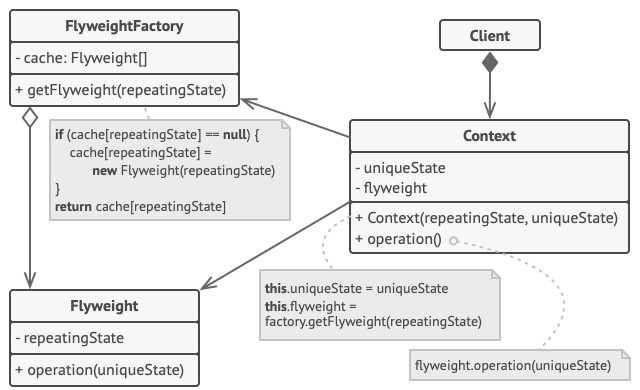设计模式解密:享元模式的终极指南(PHP/Go双实现)
一、什么是享元模式?
享元模式(Flyweight Pattern) 是一种结构型设计模式,通过共享对象来最小化内存使用和对象创建成本。其核心思想是将对象的状态分为:
内部状态(Intrinsic):可共享的恒定部分
外部状态(Extrinsic):不可共享的可变部分

二、适用场景
✅ 需要创建大量相似对象
✅ 对象的大部分状态可以外部化
✅ 内存占用是系统瓶颈
✅ 需要缓存和复用对象
✅ 游戏开发(如粒子系统、棋盘棋子)
三、PHP实现方案
1. 游戏子弹系统示例
// 享元接口
interface BulletType {
public function render(int $x, int $y): string;
}
// 具体享元
class ConcreteBulletType implements BulletType {
private $texture;
private $color;
public function __construct(string $texture, string $color) {
$this->texture = $texture;
$this->color = $color;
}
public function render(int $x, int $y): string {
return "Rendering {$this->color} bullet with {$this->texture} at ($x, $y)";
}
}
// 享元工厂
class BulletFactory {
private static $bulletTypes = [];
public static function getBulletType(string $texture, string $color): BulletType {
$key = $texture . '_' . $color;
if (!isset(self::$bulletTypes[$key])) {
self::$bulletTypes[$key] = new ConcreteBulletType($texture, $color);
}
return self::$bulletTypes[$key];
}
public static function countTypes(): int {
return count(self::$bulletTypes);
}
}
// 客户端
class Bullet {
private $type;
private $x;
private $y;
public function __construct(BulletType $type, int $x, int $y) {
$this->type = $type;
$this->x = $x;
$this->y = $y;
}
public function render(): string {
return $this->type->render($this->x, $this->y);
}
}
// 使用示例
$bullets = [];
$types = [
['metal', 'red'],
['plastic', 'blue'],
['metal', 'red'], // 重复类型
];
foreach ($types as $t) {
$type = BulletFactory::getBulletType($t[0], $t[1]);
$bullets[] = new Bullet($type, rand(0, 100), rand(0, 100));
}
foreach ($bullets as $bullet) {
echo $bullet->render() . "\n";
}
echo "Total bullet types: " . BulletFactory::countTypes(); // 输出:2四、Go实现方案
1. 文字编辑器字符优化示例
package main
import (
"fmt"
"sync"
)
// 享元接口
type CharacterStyle interface {
Render(fontSize int) string
}
// 具体享元
type ConcreteCharacterStyle struct {
fontFamily string
color string
}
func (c *ConcreteCharacterStyle) Render(fontSize int) string {
return fmt.Sprintf("Font: %s, Color: %s, Size: %d", c.fontFamily, c.color, fontSize)
}
// 享元工厂
type CharacterStyleFactory struct {
styles map[string]*ConcreteCharacterStyle
mu sync.Mutex
}
var factory = &CharacterStyleFactory{
styles: make(map[string]*ConcreteCharacterStyle),
}
func (f *CharacterStyleFactory) GetStyle(fontFamily, color string) *ConcreteCharacterStyle {
key := fontFamily + "|" + color
f.mu.Lock()
defer f.mu.Unlock()
if style, exists := f.styles[key]; exists {
return style
}
style := &ConcreteCharacterStyle{
fontFamily: fontFamily,
color: color,
}
f.styles[key] = style
return style
}
// 客户端
type Character struct {
style *ConcreteCharacterStyle
char rune
fontSize int
}
func NewCharacter(char rune, fontSize int, fontFamily, color string) *Character {
return &Character{
style: factory.GetStyle(fontFamily, color),
char: char,
fontSize: fontSize,
}
}
func (c *Character) Render() string {
return fmt.Sprintf("%c: %s", c.char, c.style.Render(c.fontSize))
}
// 使用示例
func main() {
chars := []*Character{
NewCharacter('A', 12, "Arial", "Black"),
NewCharacter('B', 14, "Times New Roman", "Red"),
NewCharacter('C', 12, "Arial", "Black"), // 复用样式
}
for _, char := range chars {
fmt.Println(char.Render())
}
fmt.Printf("Total styles created: %d\n", len(factory.styles)) // 输出:2
}五、关键实现差异对比
六、模式优缺点分析
👍 优点:
显著减少内存占用:共享重复状态
提升性能:减少对象创建开销
简化对象管理:集中存储共享状态
支持大规模对象:适用于资源敏感场景
👎 缺点:
增加代码复杂度:需要区分内外状态
线程安全问题:共享对象需同步控制
可能引入缓存膨胀:需合理控制缓存策略
七、实际应用案例
1. 游戏开发
共享武器/角色皮肤属性
复用粒子系统参数
2. 文档处理
优化字符/段落样式存储
复用富文本格式配置
3. GUI系统
共享按钮/图标样式
复用窗口主题配置
4. 电商系统
商品SKU属性共享
规格参数模板复用
八、与缓存策略的区别
九、最佳实践建议
严格区分状态:明确划分内部/外部状态
控制缓存大小:使用LRU等策略防止内存泄漏
不可变对象:共享对象应设为不可变
并发控制:多线程环境需同步机制
性能监控:统计缓存命中率优化策略
十、总结
享元模式是资源优化的艺术,通过共享不变的内在状态,它能显著降低系统内存消耗。无论是PHP的静态缓存还是Go的map+互斥锁实现,享元模式都为高并发、资源敏感场景提供了优雅的解决方案。
适用性检查清单:
系统需要创建大量相似对象
内存占用是主要瓶颈
对象的大部分状态可以外部化
愿意增加一定代码复杂度换取性能提升
在下一篇文章中,我们将探讨 责任链模式 及其在请求处理流程中的应用。敬请期待!
下一篇预告:设计模式系列(十二)——责任链模式:请求处理的流水线
License:
CC BY 4.0